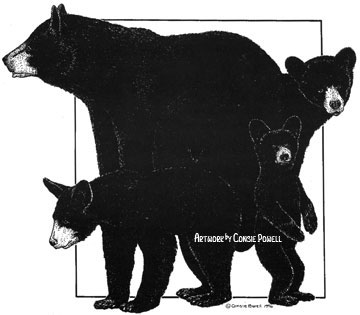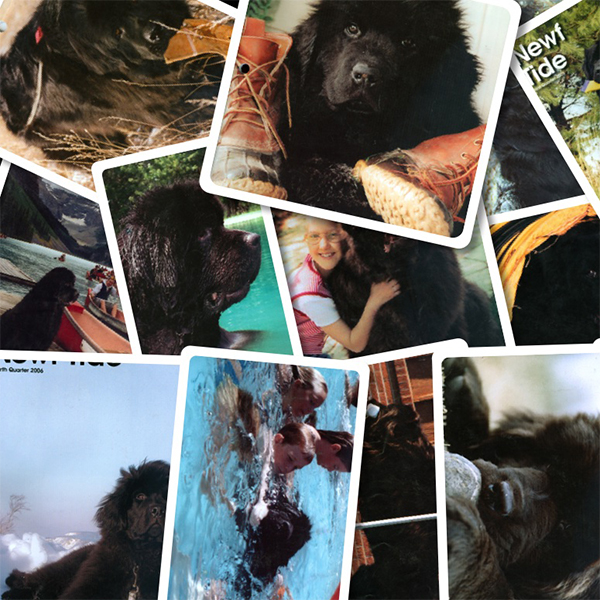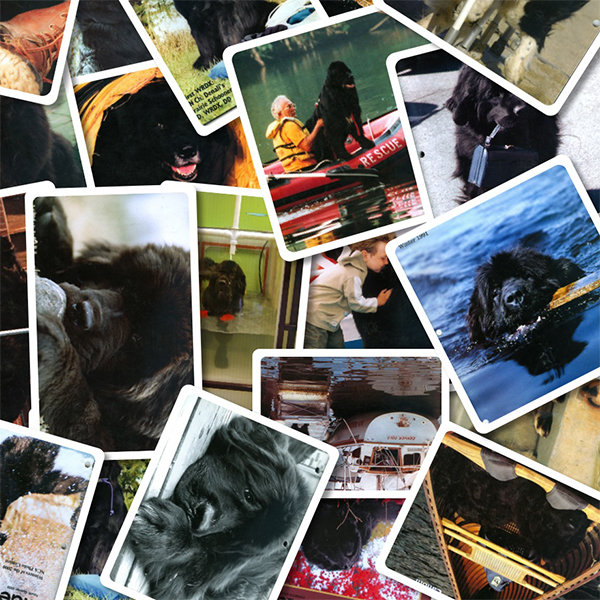by Roger Powell
Black bears are strong. I know. During 15 years of research on wild black bears, I have seen them dismember big logs searching for large beetle larvae and I have seen them toss aside logs (big logs) and huge stumps because they were in the way. What does this have to do with Newfound lands as draft dogs? Lots. Were bears highly social and domesticated, they would be the perfect freight draft animals. They are built so that, for their size, they are far stronger than a dog ever can be. |
 |
But bears are not social and not domesticated, and we live with Newfoundland dogs, not with bears. We want to have our dogs work with us, not to have bears work with us. So, let's use bears as a learning tool.
Think first about dogs. All dogs, Newfoundlands included, are descended from domesticated wolves. As such, dogs have the basic genetic materials that they inherited from wolves, and these are not genetic materials highly adapted for draft work. Wolves are basically built for running. They have long legs, reduced numbers of bones in their hocks, stifles and paws, and they walk on their toes, not on the palms of their feet. They have reduced muscle mass at the ends of their legs and paws that are, therefore, not very strong. To give their paws the strength to hold up their bodies, ligaments hold the paw bones tightly, limiting dexterity (compared to five-fingered paws of generalized mammals). And, because wolves have little need to transfer power from their hindquarters to the forequarters, their backs are relatively weak. These are exactly the wrong characteristics for draft work. To do draft work, our dogs must compensate or counteract these adaptations for running. This is where bears come in.
How should an animal be built for draft work? To be the best at draft work, an animal should have legs built for power, not for speed. Now, think about bears. Legs built for power are short and have large attachments for large muscles. Feet should be large and muscular with five toes and all the muscles that go with them. The animal should walk on the palms of its feet, not on its toes. These are a bear's legs. A back built for power is broad and muscular. Bears have strong backs so that power from their hind legs can be transferred to their forelegs to search for food under rocks and inside logs. So, you can envision a black bear in harness as the animal with the perfect build for draft work.
Excuse me while 1 now go on a tangent. Please, don't think of bears as big, clumsy animals. They are not. A wild black bear moving through the woods is a beautiful sight. It moves with incredible agility, coordination and grace. It can leap over boulders, tightrope walk along logs, maneuver rugged slopes, and slide through tight places with a grace 1 have yet to see in any domestic dog. If we could breed our dogs to have the coordination, power and grace of black bears, then our dogs would be of a quality we can hardly imagine.
Now, back to Newfs. Relative to other dogs, Newfoundlands are built for power. One important way is through brute size. Even among animals not built for power, big ones can push harder than small ones, so big size is important. (Taken to its extreme, this explains why Clydesdales are good draft animals. Even though horses are even more adapted for running than are wolves, Clydesdales are so huge that they are able to do heavy work for humans.)
Our dogs are built for power in other ways, too. They have relatively large paws. They have relatively short legs because their pasterns and hocks are relatively short for dogs and they are not highly angulated with long hind legs. They have broad, strong backs, at least for dogs, for transferring power from their hind feet to their harnesses. Remember, a draft dog does not pull his load, he pushes his harness with his chest, pushing the harness forward, and the harness and traces pull the load. Even through extensive selection and breeding to get draft animals, dogs will never be able to compensate for many aspects of simply being dogs. They will always have four functional toes on each foot and will always walk on those toes, not on their palms. They will always have tight, compact pasterns and paws. We can never add back the toes and muscles that have been lost during the evolution of wolves from a medium-sized, long-ago predator that had short legs and five toes on each foot.
What about big bones for muscle attachments? I shall stick my neck out here. Huge bone is not all that great. Here's why. First, big bones are heavy. The bigger a dog's bones, the more weight he must carry, and that can tire him. Next, bones are quite responsive to stress and use. The bodies of mammals continuously tear down and rebuild their bones. Right now, your body is diligently working to tear down your bones while simultaneously rebuilding them. Why? Bones that are subjected to regular stresses rebuild themselves to be able to meet those stresses most effectively. Consequently, the bones of healthy, active animals are built to handle the regular stresses and strains they experience. As those stresses change, the bones change in response. In addition, as an animal's muscles grow because of exercise, the area needed for attachment to bones increases. Bones grow to make that area available. What does this mean for Newfs? It means that dogs that experience regular, extensive exercise that includes hauling loads have bones that match the regular work and are no bigger and no smaller than needed. Breeding dogs for big, massive bones will not make them better draft dogs. Breeding them for healthy bodies, including healthy bones will make them good draft dogs.
Newfies who are in excellent physical condition and who receive regular, extensive exercise will have strong legs, including strong muscle development in their lower legs, and this can be noticeable as thick, sturdy legs between the pasterns and elbows. Most Newf owners, seeing such development, would think "Wow, good bone!" even though muscles would be responsible for the apparent thick legs. For many Newfs, thick hair makes their legs appear to have heavy bone when (probably fortunately) they do not.
Good joints, including hips and elbows, are important for good structure. Mother Nature is an exacting parent who does not allow her children to survive with poor structure. No bears walk for long with hip dysplasia or bad elbows. They usually starve to death before they breed. Dogs do not experience such exacting environments. Most dogs have life pretty cushy and can reach breeding age despite physical disabilities. Our dogs and we pay for this through hip dysplasia and other problems.
What if your dog has hip dysplasia or another joint problem? Can he still do draft work? Probably. Assess the rest of his structure. Is he otherwise well built? Yes? Then he can do a lot of draft work. You must keep him skinny so that his joints do not have to carry more weight than necessary (this is good for any dog but critical for dysplastic dogs). And you must keep him in excellent physical condition so that his muscles can compensate for his structural problems. Then, get to work, the two of you, and enjoy the work together. Your dog can do lots of draft work, for years. I own a nine-year-old dysplastic girl who has always been an exceptional worker and who still loves her harness.
What if the rest of your dog's structure is not perfect? You can still do some draft work but you must gauge your demands to his physical abilities. Keep him slim, trim and in good condition and watch him like a hawk while you work together. Just before he shows any sign of stress, stop work. You say, "Right. How can I gauge that he is not quite at his limit?" You do this by being familiar with how he works and plays and from having watched him closely while working and playing with him time and time again.
Reading your dog is important. Newfoundlands will work their hearts out for their people. They are trusting, generous and giving and will work to the point of injury because they want to please their people. You must read your dog well to make his work safe and to keep him from being injured.
For now, give your draft dog a hug from me.
reprinted from NewfTide 1997

